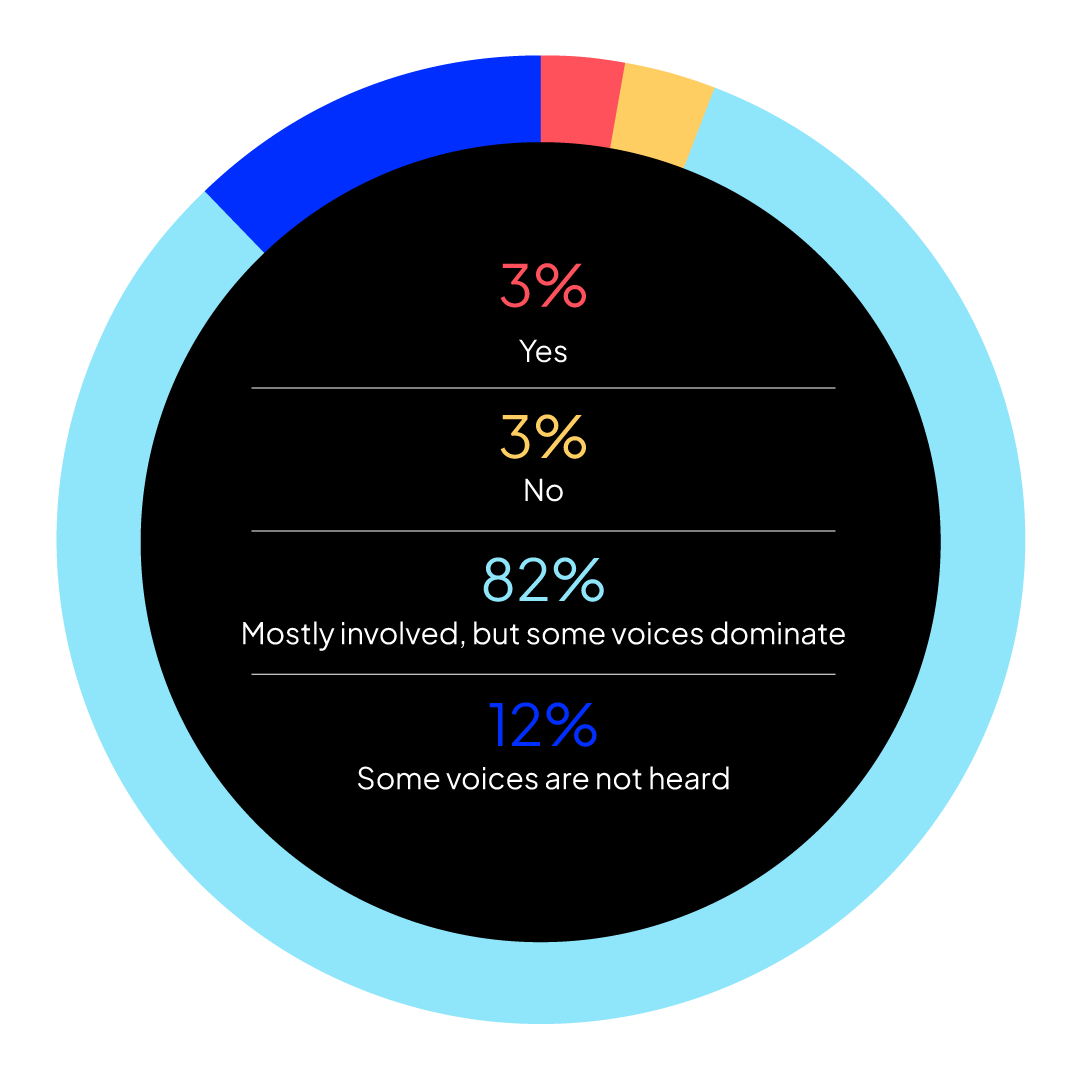Question 1When a problem comes up in your workplace - what’s the standard procedure?
48% of people surveyed reported that their problem solving approach involves an endless cycle of meetings.
Most teams tend react to problems with meetings, and not momentum - resulting in committee driven solutions, often led by the loudest person in the room (or a person in the wrong place at the wrong time)
The default instinct is talk, not act - to discuss rather than decide. This isn’t really a reflection of the organisations capability, it’s a symptom of its culture.
Without a shared framework or direction - problems get talked into the ground while accountability evaporates - and often the loudest voice will steer the ship, even if it’s heading for the rocks.
What They Said“Meetings. Meetings. Meetings. And if that doesn’t work… another meeting to figure out why”
Key TakeawayThe absence of a clear problem solving procedure means the loudest voice often becomes the compass, whether it’s right or not.
Question 2Who is in charge of solving problems and / or issues?
Over half of respondents (57%) said that problem solving is handled collectively, as a team.
Problem ownership is a grey area - and that’s a problem in itself. While collaboration is valued - it is often the people who raise problems that are tasked with fixing them (reluctantly).
A lot of people named the team leader as the go to person for all issues, while others sought out whoever was nearby and willing to get involved - describing a culture where the same people always end up tackling issues because no one else will.
Problem solving often lacks clear ownership. There’s great intention to work together, but with a lack of defined roles - problems can quietly compound.
What They Said“The more you do - the more you are expected to do”
Key TakeawayCollaboration is essential - but so is clarity. Without clear responsibility, problems can be passed around like hot potatoes instead of being solved.
Question 3Are major problems confined to specific departments, or is there cross department task groups set up to address them?
Only 1 in 3 organisations say they regularly bring departments together to solve big problems.
Around a third of teams actively collaborate across departments, another third stick to their silos, and the rest only come together when things get out of hand.
This paints an inconsistant picture. While some organisations are using their collective expertise - others are stuck behind departmental walls - regardless of how interconnected the problem may be within the company.
Departmental specialisation is a valuable asset - but when it comes to complex challenges, broad perspectives matters more. Complex problems rarely sit neatly in one area, and neither should the solutions.
What They Said“We need look after our own issues and can’t expect help from other departments”
Key TakeawayCross department collaboration shouldn’t need alarm bells ringing to start conversations
Question 4Is there a framework or system for problem-solving in your organisation?
About 60% of participants have a problem solving framework in place, but not everyone agrees if they work.
The majority of respondents mentioned having a structured problem solving framework in place, such as Six Sigma or Agile methodologies, but also mention being a slave to those frameworks.
Altough larger organisations have clearly defined approaches, some of these approaches were more theory than practice. Many other organisations described having less effective problem solving methods like mild panic, hope and blame.
One standout theme was confusion. Even where frameworks exist - it’s not always clear how to use them. The best problem solving frameworks are human friendly .
What They Said“Kind of, we have a general process, but it’s not consistent - it often falls to the same group of individuals”
Key TakeawayA clearly defined / shared problem solving framework gives people the confidence to tackle issues with clarity and ownership.
Question 5Is there a clear system for executing solutions once agreed upon?
Nearly 40% of respondents said there is no clear system for executing solutions.
Most respondents said their organisation has a clear system for executing agreed solutions, but a significant majority said there’s no defined method in place.
A system for turning ideas into action often gets lost in the post meeting fog. Even the best solutions can drift away if there’s no clarity around who’s doing what, when, and how.
Having a system doesn’t guarantee success, but not having one guarantees chaos. Following through on an agreed course of action is an essential part of the solution. One thing is clear - too many ideas get lost in the Bermuda Triangle between agreement and execution.
What They Said“Common consensus across multiple different styles and personalities is almost impossible”
Key TakeawayWithout action - the solution is just another conversation.
Question 6Do you find that problems are correctly identified?
Roughly 1 in 3 people said problems are identified correctly.
The vast majority of feedback said that problems are correctly identified “sometimes”. Only a small group said their organisation consistently gets to the heart of the issue.
It appears there’s a lack a structured diagnosis around problem solving, where people are eager to jump in and start solving symptoms without properly identifying the problem.
A few respondants mentioned time pressures and surface level fixes that prioritise speed over understanding - resulting in a lot of time and energy spent fixing the wrong thing.
What They Said“The problems tend to be long term, not spontaneous”
Key TakeawayA solution is only as good as the problem it’s based on - If the foundation is shaky, the whole thing wobbles.
Question 7Is everyone involved comfortable sharing their ideas within the problem solving sessions?
82% of participants said that everyone is mostly involved, but that certain voices dominate.
Common in every situation, strong personalities tend to dominate meetings, and while a lot of these louder voices are well-meaning, it can be a deterrent to every person contributing.
Added to that, there is a natural tendency to defer to the HiPPO (highest paid person's opinion) and so ideas and solutions can be easily skewed.
Although leadership and decisiveness is important, allowing space for everyone to contribute fully means that diverse discussions and solutions can present.
An added bonus to this approach is an increase in intrinsic motivation for each participant — the more ownership we feel over decisions being made (however small), the more likely we are to fully buy-in.
What They Said“A structure for allowing less loud voices in the crowd voice their opinion without fear of an argument with the one loud ( well-wishing) person”
Key TakeawayDesigning an approach and a system for psychological safety allows for more rounded and inclusive conversations.
Question 8Does your company’s approach to workplace problem solving reflect your company’s values?
70% of participants are unsure if their company values and culture are being fully utilised.
One of the more astute observations we received was that culture is a double-edged sword.
When it’s clearly defined in everyone’s mind, common understanding is easier. It can be used as a practical tool to make decisions and push forward together. There’s less chance of people misinterpreting it and going in different directions.
When it’s ill-defined, or simply aspirational words, people can interpret it to suit their own needs. This ambiguity leads to many different paths being forged and increases uncertainty.
The fact that so many respondents are not confident about their company values reveals that a lot of workplace aspects could benefit from a refresher course in their Northstars.
What They Said“Culture can be both a northstar and a detriment if people have no shared interpretation and understanding of it. People will pick and choose principles as it fits their narrative and needs.”
Key TakeawayValues and culture building is only useful when every member of a team or company has a shared understanding of them.
Question 9How would you describe your Team’s problem solving method?
60% of participants said that there was no grand strategy involved but everything normally worked out for the best.
We asked people to compare their methods to a movie, and more than one mentioned The Big Lebowski. Chaotic, but everyone pulls together and abides.
The romantic in us quite likes the idea of embracing the chaotic so we’d like to give our blessing and move on.
Yet, this does sound like quite an inefficient way to do business. And most likely it’s stressful while it’s happening. We wonder if there’s an element of the peak–end rule in play here.
Looking back, participants remember the peak (the height of the chaos) and the end (the favourable resolution) and judge the overall experience as positive. Who needs a strategy!?
What They Said“Collaborative but chaotic. We get there in the end but it’s painful.”
Key Takeaway








